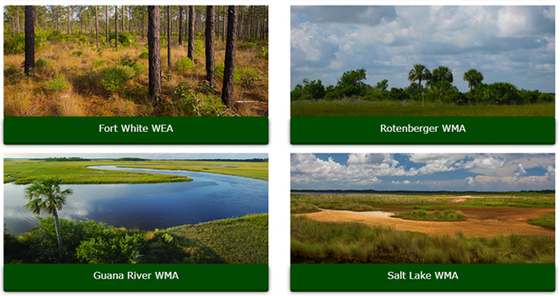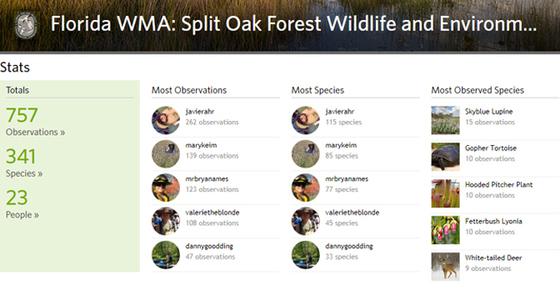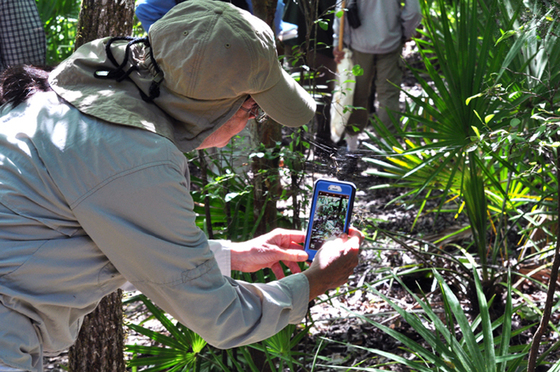|
By Peter Kleinhenz
Have you used a phone app today? I’d be willing to bet that,
for most people reading this, the answer is an easy “yes.” You might have
repaid your friend for dinner on Venmo, listened to a few tunes on Spotify or eagerly
checked for new notifications on Facebook. By now, you’re probably thinking
that I’ve really gone off the rails this time. How could a phone app have
anything to do with nature, conservation or the Florida Fish and Wildlife
Conservation Commission (FWC)?
The answer is simple: iNaturalist. This app, what I call the
“Facebook of natural history,” allows the user to upload observations of life
that they observe and to interact with others who do the same thing. The
process to do this is straightforward. You go out exploring, find something cool, take
its picture, let iNaturalist suggest an identification for you (unless you
already know what it is), and click “share.” You can then identify finds that
others make, add your observations to projects that you join or browse your favorite wildlife management area
hiking spot to see what has been observed there.
 Upload your wildlife observations using iNaturalist, photo by Peter Kleinhenz
Over the past year, FWC has worked with iNaturalist to create the “Florida Nature Trackers” program. Various taxonomic groups have
their own projects that you can join and add observations to. For instance,
let’s say that you spot a cool orange butterfly fluttering around your yard.
You could snap its photo in iNaturalist and add it to the “Pollinators
of Florida” or “Insects of
Florida” project. Helpful, knowledgeable members of the iNaturalist community will then come in and help you identify your observation. Your "orange butterfly" may metamorphose into a monarch or a gulf fritillary.
The majority of “Florida Nature Trackers”
projects are wildlife
management area (WMA) projects. Every WMA managed solely by FWC, in fact,
has its own project. Many observations that people add get incorporated into
plans that help land managers better understand what species occur on their
areas and how they are distributed. Five surveys in a row may fail to document
something like an eastern indigo snake, but maybe you get lucky and see one
when you’re out driving through a nearby WMA. Your observation, then, of this
endangered snake matters.
 Examples of the Florida Nature Trackers projects you can join at FloridaNatureTrackers.com
So far, over 12,300 people have added over 107,500 observations
to Florida Nature Trackers projects. Many represent observations of common
species, but many do not. The thousands of observations submitted substantially
add to our body of knowledge about the species inhabiting Florida. At a time
when threats to natural ecosystems abound, this data has the ability to further
our understanding of the distribution of species in our state.
Florida Nature Trackers does not only apply to habitats “out
there.” FWC has created a brand-new program titled “Backyards and Beyond” where
the goal is to raise awareness about the habitats found, not surprisingly, in our
own backyards. Stop and think about it: so much potential wildlife habitat
exists in our collective backyards. Even a couple native plants grown around
the edge of your house can benefit native creatures. Using iNaturalist, you can
now join the Backyards
of Florida project and even add observations from your own property to your
yard’s very own project. That way, you’ll be able to see the direct impact of
enhancements made to your yard in terms of the life that you record there over
time.
 Adding your observations to a project will provide biologists with valuable information about the area
If this sounds like a sales pitch, that’s because it is.
I’ve become enamored with iNaturalist as my familiarity with it has increased.
Recently, I documented (and subsequently learned to identify) seven
species of cactus that I found growing along the Rio Grande River in south
Texas. I connected a herpetologist who had posted photos of a critically
endangered salamander species on iNaturalist with the Florida Natural Areas
Inventory so that his records could help fill in data gaps. I even participated
in a friendly online debate about why a dwarf sundew was a dwarf sundew. The
point is this: if you love nature, there are millions of other people out there
who feel the same way. This app allows you to connect with them and benefit
your understanding, and the understanding biologists have, about where species
occur at the same time.
You might be wondering about how someone who has written
about the value of getting people outside and who spends all of his free time
exploring nature could champion a phone app like this. Aren’t phones destroying
the ability of the next generation to connect with the natural world? Yes and
no. They certainly have limited the exposure time that people have with the
outdoors. At the same time, apps such as iNaturalist require time in nature. In other words, technology and nature do
not have to be mutually exclusive.
 Use technology to share your enjoyment of the outdoors, photo by Peter Kleinhenz
If
your smart phone is beside you right now, take a look at the apps you have. If
iNaturalist isn’t one of them, consider adding it. If you haven’t visited floridanaturetrackers.com,
consider visiting. If you haven’t been outside exploring this
week, consider doing just that. Smart phones aren’t going away any time soon,
and if we’re smart and creative about how to use them to our environment’s
advantage, then neither is nature.
To create your very own backyard Nature Trackers project, check out this instructional video!
To find out more about our Backyards and Beyond initiative,
subscribe to the Backyards
and Beyond GovDelivery topic.
 Share a photograph of an interesting find at one of the wildlife management areas, FWC photo
|